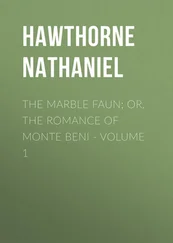“You speak in vain,” replied the young man, with a deeper emphasis than she had ever before heard in his voice; “shroud yourself in what gloom you will, I must needs follow you.”
“Well, well, well,” said Miriam impatiently; “but leave me now; for to speak plainly, my good friend, you grow a little wearisome. I walk this afternoon in the Borghese grounds. Meet me there, if it suits your pleasure.”
CHAPTER VI
THE VIRGIN’S SHRINE
Table of Contents
After Donatello had left the studio, Miriam herself came forth, and taking her way through some of the intricacies of the city, entered what might be called either a widening of a street, or a small piazza. The neighborhood comprised a baker’s oven, emitting the usual fragrance of sour bread; a shoe shop; a linen-draper’s shop; a pipe and cigar shop; a lottery office; a station for French soldiers, with a sentinel pacing in front; and a fruit-stand, at which a Roman matron was selling the dried kernels of chestnuts, wretched little figs, and some bouquets of yesterday. A church, of course, was near at hand, the facade of which ascended into lofty pinnacles, whereon were perched two or three winged figures of stone, either angelic or allegorical, blowing stone trumpets in close vicinity to the upper windows of an old and shabby palace. This palace was distinguished by a feature not very common in the architecture of Roman edifices; that is to say, a mediaeval tower, square, massive, lofty, and battlemented and machicolated at the summit.
At one of the angles of the battlements stood a shrine of the Virgin, such as we see everywhere at the street corners of Rome, but seldom or never, except in this solitary, instance, at a height above the ordinary level of men’s views and aspirations. Connected with this old tower and its lofty shrine, there is a legend which we cannot here pause to tell; but for centuries a lamp has been burning before the Virgin’s image, at noon, at midnight, and at all hours of the twenty-four, and must be kept burning forever, as long as the tower shall stand; or else the tower itself, the palace, and whatever estate belongs to it, shall pass from its hereditary possessor, in accordance with an ancient vow, and become the property of the Church.
As Miriam approached, she looked upward, and saw, — not, indeed, the flame of the never-dying lamp, which was swallowed up in the broad sunlight that brightened the shrine, but a flock of white doves, skimming, fluttering, and wheeling about the topmost height of the tower, their silver wings flashing in the pure transparency of the air. Several of them sat on the ledge of the upper window, pushing one another off by their eager struggle for this favorite station, and all tapping their beaks and flapping their wings tumultuously against the panes; some had alighted in the street, far below, but flew hastily upward, at the sound of the window being thrust ajar, and opening in the middle, on rusty hinges, as Roman windows do.
A fair young girl, dressed in white, showed herself at the aperture for a single instant, and threw forth as much as her two small hands could hold of some kind of food, for the flock of eleemosynary doves. It seemed greatly to the taste of the feathered people; for they tried to snatch beakfuls of it from her grasp, caught it in the air, and rushed downward after it upon the pavement.
“What a pretty scene this is,” thought Miriam, with a kindly smile, “and how like a dove she is herself, the fair, pure creature! The other doves know her for a sister, I am sure.”
Miriam passed beneath the deep portal of the palace, and turning to the left, began to mount flight after flight of a staircase, which, for the loftiness of its aspiration, was worthy to be Jacob’s ladder, or, at all events, the staircase of the Tower of Babel. The city bustle, which is heard even in Rome, the rumble of wheels over the uncomfortable paving-stones, the hard harsh cries reechoing in the high and narrow streets, grew faint and died away; as the turmoil of the world will always die, if we set our faces to climb heavenward. Higher, and higher still; and now, glancing through the successive windows that threw in their narrow light upon the stairs, her view stretched across the roofs of the city, unimpeded even by the stateliest palaces. Only the domes of churches ascend into this airy region, and hold up their golden crosses on a level with her eye; except that, out of the very heart of Rome, the column of Antoninus thrusts itself upward, with St. Paul upon its summit, the sole human form that seems to have kept her company.
Finally, the staircase came to an end; save that, on one side of the little entry where it terminated, a flight of a dozen steps gave access to the roof of the tower and the legendary shrine. On the other side was a door, at which Miriam knocked, but rather as a friendly announcement of her presence than with any doubt of hospitable welcome; for, awaiting no response, she lifted the latch and entered.
“What a hermitage you have found for yourself, dear Hilda!” she, exclaimed. “You breathe sweet air, above all the evil scents of Rome; and even so, in your maiden elevation, you dwell above our vanities and passions, our moral dust and mud, with the doves and the angels for your nearest neighbors. I should not wonder if the Catholics were to make a saint of you, like your namesake of old; especially as you have almost avowed yourself of their religion, by undertaking to keep the lamp alight before the Virgin’s shrine.”
“No, no, Miriam!” said Hilda, who had come joyfully forward to greet her friend. “You must not call me a Catholic. A Christian girl — even a daughter of the Puritans — may surely pay honor to the idea of divine Womanhood, without giving up the faith of her forefathers. But how kind you are to climb into my dove-cote!”
“It is no trifling proof of friendship, indeed,” answered Miriam; “I should think there were three hundred stairs at least.”
“But it will do you good,” continued Hilda. “A height of some fifty feet above the roofs of Rome gives me all the advantages that I could get from fifty miles of distance. The air so exhilarates my spirits, that sometimes I feel half inclined to attempt a flight from the top of my tower, in the faith that I should float upward.”
“O, pray don’t try it!” said Miriam, laughing; “If it should turn out that you are less than an angel, you would find the stones of the Roman pavement very hard; and if an angel, indeed, I am afraid you would never come down among us again.”
This young American girl was an example of the freedom of life which it is possible for a female artist to enjoy at Rome. She dwelt in her tower, as free to descend into the corrupted atmosphere of the city beneath, as one of her companion doves to fly downward into the street; — all alone, perfectly independent, under her own sole guardianship, unless watched over by the Virgin, whose shrine she tended; doing what she liked without a suspicion or a shadow upon the snowy whiteness of her fame. The customs of artist life bestow such liberty upon the sex, which is elsewhere restricted within so much narrower limits; and it is perhaps an indication that, whenever we admit women to a wider scope of pursuits and professions, we must also remove the shackles of our present conventional rules, which would then become an insufferable restraint on either maid or wife. The system seems to work unexceptionably in Rome; and in many other cases, as in Hilda’s, purity of heart and life are allowed to assert themselves, and to be their own proof and security, to a degree unknown in the society of other cities.
Hilda, in her native land, had early shown what was pronounced by connoisseurs a decided genius for the pictorial art. Even in her schooldays — still not so very distant — she had produced sketches that were seized upon by men of taste, and hoarded as among the choicest treasures of their portfolios; scenes delicately imagined, lacking, perhaps, the reality which comes only from a close acquaintance with life, but so softly touched with feeling and fancy that you seemed to be looking at humanity with angels’ eyes. With years and experience she might be expected to attain a darker and more forcible touch, which would impart to her designs the relief they needed. Had Hilda remained in her own country, it is not improbable that she might have produced original works worthy to hang in that gallery of native art which, we hope, is destined to extend its rich length through many future centuries. An orphan, however, without near relatives, and possessed of a little property, she had found it within her possibilities to come to Italy; that central clime, whither the eyes and the heart of every artist turn, as if pictures could not be made to glow in any other atmosphere, as if statues could not assume grace and expression, save in that land of whitest marble.
Читать дальше












